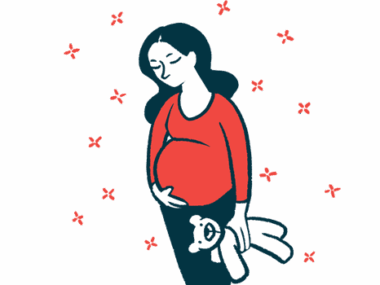Case highlights challenges of treating Cushing’s in pregnancy
Conservative treatment tied to complications, but ultimately, recovery
Written by |

A team of clinicians in China successfully diagnosed and treated a 28-year-old woman with pregnancy-complicated Cushing’s syndrome, with both mother and child making full recoveries after a Cesarian section delivery at nearly eight months’ gestation, a study reports.
The obstetrical team attempted “active complication management,” but otherwise followed a conservative approach in their treatment of the pregnant woman — which, “besides avoiding surgery, … may have contributed to extended gestational duration” for the fetus, the researchers wrote.
However, during the later stages of the pregnancy, the mother developed heart failure, which led to the baby’s emergency delivery at 31 weeks’ gestation.
According to the clinicians, “this case highlights the diagnostic challenges of Cushing’s syndrome during pregnancy … and the importance of multidisciplinary management, while also demonstrating how this rare endocrine disorder can significantly impact maternal and fetal outcomes.”
The case report, “Adrenal Cortical Adenoma-Induced Cushing’s Syndrome in Pregnancy: A Multidisciplinary Approach to Diagnosis and Management,” was published in the journal Current Problems in Surgery.
Overlap between the symptoms of Cushing’s and features commonly seen in pregnancy — such as weight gain, high blood pressure, known as hypertension, and diabetes — had complicated the woman’s diagnosis, the researchers reported. The clinicians began with a conservative approach by treating the woman’s symptoms, but heart failure, alongside other serious complications, prompted the eventual Cesarian section, followed two months later by a surgery to address the underlying causes of Cushing’s.
In Cushing’s syndrome, high levels of the hormone cortisol lead to symptoms such as skin abnormalities and a round, moon-shaped face. The underlying cause can vary, but it often involves a tumor — either in the adrenal glands above the kidneys or in the pituitary gland of the brain. When the tumor is in the pituitary and causes excess production of adrenocorticotropic hormone (ACTH), the condition is specifically referred to as Cushing’s disease, a common form of ACTH-dependent Cushing’s syndrome.
In contrast, adrenal tumors, called adenomas, can cause the adrenal glands to produce too much cortisol directly, leading to ACTH-independent Cushing’s syndrome. An adenoma was identified as the cause in this case.
When possible, treatment often begins with surgery to remove the tumor. Indeed, the researchers noted that “surgery should be performed as soon as possible after diagnosis to avoid irreversible organ damage caused by long-term cortisol excess.”
Pregnancy and other complications may make surgery more complicated, prompting other therapeutic approaches.
Overlapping signs of Cushing’s, pregnancy complicated diagnosis, treatment
In this case study, the researchers described how these overlapping factors impacted diagnosis and treatment for a woman in her late 20s during her first pregnancy. The woman had no previous medical issues, but nine weeks into pregnancy, she experienced changes in her skin and had a moon-shaped face. Other tests indicated no notable abnormalities at this point, but several issues arose in tests around 22 weeks.
Her cortisol levels were higher than expected in most pregnancies, and she had low potassium and high blood pressure. An ultrasound showed a nodule on the right adrenal gland. Despite potential risks to the fetus, the clinicians performed an MRI, allowing them to identify an adenoma, suggesting Cushing’s syndrome.
As a conservative measure, the team did not operate or initiate other treatments that could negatively impact the pregnancy. Instead, the woman began taking medications for blood pressure management and potassium supplementation.
“Subsequent monitoring of the patient indicated that her blood pressure and potassium levels were restored to the normal range,” the researchers wrote.
Around 31 weeks into gestation, the woman again began experiencing high blood pressure, followed by signs of heart failure, including difficulty breathing and chest discomfort. An echocardiogram found abnormalities in heart structure and function. The team considered this a critical condition, and performed an emergency cesarean section, delivering a baby girl who was transferred to the neonatal intensive care unit for further treatment..
Researchers question conservative vs. more aggressive approach
After initial recovery, the mother received ongoing treatment for her heart problems, high blood pressure, and low potassium. She also began lactation suppression and hormonal therapy to address cortisol levels.
Six weeks later, however, she still had abnormally high cortisol levels. Additional imaging revealed a microtumor in her pituitary gland, but follow-up testing suggested the woman had a non-ACTH-dependent form of Cushing’s, with the adrenal adenoma being the source of excess cortisol. A minimally invasive surgery successfully removed the adenoma, and the patient was discharged nine weeks after delivery.
Three months after giving birth, the patient showed improvement in the acne-like skin eruptions on her face, chest, and back. She continued being treated with medication for high blood pressure and hormones, and her blood pressure was well controlled. Cortisol and ACTH hormone levels were within normal range.
Investigation is needed to determine whether mid-gestational diagnosis and more aggressive surgical intervention might extend gestational duration, potentially preventing late-stage heart failure complications.
Her baby was discharged after 40 days of care. By eight months postpartum, her medications were gradually stopped, and follow-up tests, including blood pressure, potassium levels, and heart ultrasound, all came back normal. At the one-year checkup, both mother and baby were in good health.
Throughout the process, the clinical team prioritized both maternal and fetal health, resulting in a relatively conservative course of treatment, the report noted. However, the researchers suggested that a different treatment strategy possibly could have helped avoid some of the complications the woman experienced.
“Investigation is needed to determine whether mid-gestational diagnosis and more aggressive surgical intervention might extend gestational duration, potentially preventing late-stage heart failure complications,” the researchers wrote.







